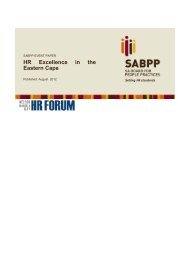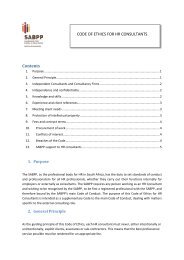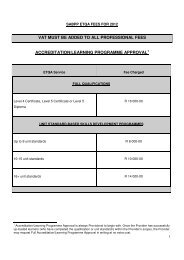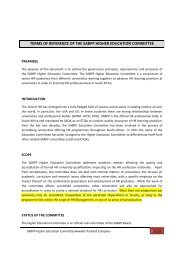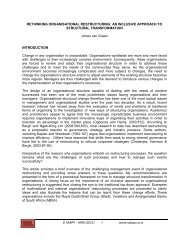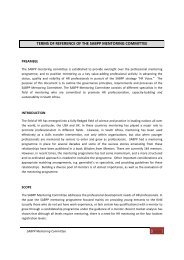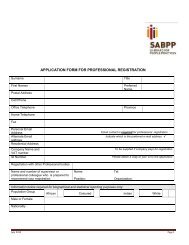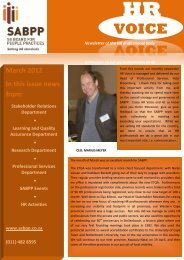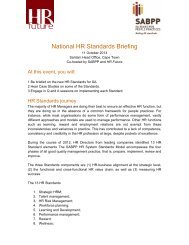1 © SABPP â HRRI (2011) | www.sabpp.co.za LEARNING ...
1 © SABPP â HRRI (2011) | www.sabpp.co.za LEARNING ...
1 © SABPP â HRRI (2011) | www.sabpp.co.za LEARNING ...
You also want an ePaper? Increase the reach of your titles
YUMPU automatically turns print PDFs into web optimized ePapers that Google loves.
12.What had happened to almost all of the oil in the Temple?a) It had been defiled b) It was dirtyc) It had been stolen d) It had been used for <strong>co</strong>okingThe oil for the Temple Menorah had to be, ac<strong>co</strong>rding to Torah law, pureolive oil. What is pure olive oil? Pure olive oil (and this will explain why ittook so long to get more) is made using just the first drop of each olive. Justas today we have “safety seals” to ensure that our food was not tamperedwith, the jars of oil for the Menorah were sealed with the seal of the HighPriest. When the Maccabees drove the Syrian-Greeks out of the Temple, theyfound that the seals on all but one flask had been broken, rendering themunusable since it was impossible to tell whether or not the oil had been usedfor any idolatrous worship. The pure olive oil was thus defiled.13. The patriarch of the Maccabee clan was:a) Judah b) Matityahu (Mattathias)c) Jonathan d) Johanan(See answer to question 15.)14. The Maccabee rebellion began at a public ceremony of a Jew:a) Working on Shabbat b) Eating shrimpc) Sacrificing a pig d) Bowing to an idol(See answer to question 15.)15. Another name for the Maccabees is:a) Hasmoneans b) Karaitesc) Levites d) IsraelitesIn the town of Modiin, west of Jerusalem, lived a man named Matityahu(Mattathias). He was from the Hasmonean family, which was one of thebranches of the Kohanim (priests). In 167 B.C.E., Syrian-Greek soldiers cameto the town and demanded that the Jews sacrifice a pig to one of their gods.Knowing that Matityahu was <strong>co</strong>nsidered a righteous leader,they singled him out. But Matityahu refused to sacrificethe animal, even under threat of death.Not all the Jews of Modiin were so brave and devoted.When one of his fellow townsmen stepped forward andvolunteered to sacrifice the pig, Matityahu, outraged at the treacherousact, grabbed a sword and slew the heretic. Matityahu’s sons joined himand they attacked the soldiers, decimating the enemy by the end of the day.Matityahu and his sons then fled Modiin and took refuge in the hills.While Matityahu began the revolt, he did not live to see its end. After hispassing, within a year of the start of the revolt, the leadership was taken upby his son Judah, a valiant soldier and a wise tactician. In the hills, Judahgathered a band of Jewish freedom fighters who were prepared to fight forthe Jewish way of life. They became known as the Maccabees.16. The Chanukah story is found in which Biblical book?a) Estherb) Kings IIc) Ruthd) There is no Biblical book <strong>co</strong>ncerning ChanukahThe Book of Maccabees, which related the story of Chanukah, is what isknown as Apocrypha, non-Biblical texts. The books of the Apocrypha areoften related to the Biblical texts, and written in a similar style, but wereeither written after the sages closed the Biblical canon (as is the case of theBook of Maccabees) or were not seen to have prophetic insights to guide the
Table 1: The five disciplines as originated by Senge1990The fiveDescriptionsdisciplinesPersonal Personal Mastery involves individuals being more realistic about whom they really areMastery and focused on be<strong>co</strong>ming the best person possible and to strive for a sense of<strong>co</strong>mmitment and excitement in their careers. Individuals learn to expand their ownpersonal capacity to create the results they desire.Mental Mental models are deeply ingrained assumptions, generalisation or picture images thatmodels influence how people understand the world and the action they take. This involves eachindividual reflecting upon, <strong>co</strong>ntinually clarifying and improving their picture image of theworld and seeing how they shape personal actions and decisions.Shared A shared vision is a picture of the future which is shared by all. It involves individualsvision building a sense of <strong>co</strong>mmitment within particular workgroups, developing shared imagesof <strong>co</strong>mmon and desirable futures, and principles and guiding practices to support thejourney to such a future.Team Team learning is a process of developing the ability to create desired results, to have aLearning goal in mind and work together as a team to achieve it. It involves relevant thinking skillsthat enable groups of people to develop intelligence and an ability that is greater thanthe sum of individual members.System System thinking is the discipline that is at the heart of the learning organisation. Itthinking integrates all others disciplines and <strong>co</strong>mpels everyone in the organisation to see theiractions as inter<strong>co</strong>nnected and as part of the organisation in terms of its structures,processes, thinking and behaviours.Ac<strong>co</strong>rding to Cors (2003:4) Senge suggests that that people put aside their old ways of thinking(mental models), learn to be open with others (personal mastery), understand how their <strong>co</strong>mpanyreally works (systems thinking), form a plan everyone can agree on (shared vision), and then worktogether to achieve that vision (team learning). In many organisations learning does take placethrough day to day interactions, however this learning takes place randomly and tends to be learningfor the sake of learning. The learning organisation approach <strong>co</strong>mpels organisation to make adeliberate effort to learn, and to learn at individual, team and organisational level whilst alsomaintaining focus on the impact of the learning that has taken place, in order to achieve positive anddesired out<strong>co</strong>mes.5 © <strong>SABPP</strong> – <strong>HRRI</strong> (<strong>2011</strong>) | <strong>www</strong>.<strong>sabpp</strong>.<strong>co</strong>.<strong>za</strong>
The realisation is that learning is a multidimensional, multi team and dynamic process that requires the<strong>co</strong>mmitment of all individuals to share the same vision work towards achieving the same goals toenable the organisation to remain a formidable player in the relevant markets. The Boston ConsultingGroup (2008:1) states that <strong>co</strong>mpanies that fine-tune their systems by creating what is called peopleadvantage i.e. the ability to gain <strong>co</strong>mpetitive advantage through people strategies will rise ahead oftheir <strong>co</strong>mpetitors. Armstrong & Foley (2003:74) refer to organisational learning mechanisms as culturalfacets of an organisation that facilitates the development of and improvement to the renewal of alearning organisation. Armstrong ibid, suggests that without these mechanisms a learning organisationmight not emerge.The alignment of organisational activities to these mechanisms is a simplistic way of guiding theorganisation towards the successful implementation of a learning organisation. Figure 1 illustrates theinteraction of organisational mechanisms that enables organisational renewal within a learningorganisation. The importance of systems thinking as a discipline cannot be overemphasised as itpoints to the organisational mechanisms that should operate as a system to give the desired positiveout<strong>co</strong>mes. All of the above mechanisms need to be integrated into one whole in order to enableorganisational learning to move swiftly in facilitating a learning organisation.LeadershipOrg.LearningmechanismsSystemsStructuresProcessesPracticesLearningorganisationCompetitive&SustainableWorkforceFigure 1: An illustration of learning organisation mechanismsAs a mechanism organisational learning is very key to the achievement of a learning organisation. Abrief description of organisational learning follows.4. ORGANISATIONAL <strong>LEARNING</strong>Organisational learning a is a system of actions and actors, symbols and processes that enables anorganisation to transform information into valued knowledge which in turn increases its long run6 © <strong>SABPP</strong> – <strong>HRRI</strong> (<strong>2011</strong>) | <strong>www</strong>.<strong>sabpp</strong>.<strong>co</strong>.<strong>za</strong>
adaptive capacity (Schwandt,1993 in Gorelick, 2005:384). It is related to individual behaviour in anorganisation and the organisations ability to respond to change in its environment (Mets & Torokoff(2007:140). It implies that individuals learn as agents of the organisation ac<strong>co</strong>rding to Argyris andothers in Örtenblad (2001:125). Organisational learning is about increasing an organisations problemsolving capacity and also changing behaviours in such a way that leads to improved performance atindividual, team and organisational level as suggested by Steward (2001:142). Finally, it is about anorganisations deeper understanding of how it learns and also how it structures its learning aroundwhat it has understood, rather than just engaging in learning programmes that are not necessarilydriven by a specific out<strong>co</strong>me and value.This implies that knowledge acquired by the individuals is transferred to the organisational memory,through processes, systems and practices created deliberately to facilitate learning. It can be statedthat organisational learning is about activities and processes that enable an organisation to achievebigger more tangible out<strong>co</strong>mes that enables the achievement of learning organisation status. Forinstance, in a given organisation, organisational learning can refer to processes of learning includingsupport structures like policies, the culture, practices and the effective distribution of resources thatenable learning to take place.Ac<strong>co</strong>rding to Curado (2006:26), most researchers <strong>co</strong>nsider organisational learning as the product oforganisational members involvement in the interaction and sharing of experiences and knowledge.They are also <strong>co</strong>ncerned with how does an organisation learn and aim to describe the process ofongoing learning. This implies that individual learning is a necessary, but not sufficient <strong>co</strong>ndition forlearning to take place. The observation and analysis of the processes involved in individual and<strong>co</strong>llective learning inside the organisation is the focus of organisational learning. Armstrong and Foley(2003:74) suggest that the underlying organisational structures referred to as Organisational LearningMechanisms (OLMs) facilitate the development of, improvement to and renewal of a learningorganisation. They <strong>co</strong>nclude that without these mechanisms, a learning organisation is unlikely toemerge. Table 2 illustrates the differences between organisational learning and the learningorganisation.7 © <strong>SABPP</strong> – <strong>HRRI</strong> (<strong>2011</strong>) | <strong>www</strong>.<strong>sabpp</strong>.<strong>co</strong>.<strong>za</strong>
Table 2: The distinction of a learning organisation and organisational learningOrganisational LearningLearning organisation1. Addresses the how? (Cors, 2003:332) It is a Addresses the what? i.e. it is the end state, ameans to an end for instance it describes form of organisation that operates in a particularthe activities that take place.way.2. Focus is on individual learners ac<strong>co</strong>rding to Focus of learning is at individual, team andKontoghiorghes et.al (2005: 185).organisational level.Individuals learn as agents of theorganisation.3. Variety of types of learning (Cors, 2003:27), Organisation has specific descriptive ande.g. programme to acquire specific skills, established organisational systems like vision,accelerated leadership development mission, strategy, culture, structure andprogrammes.processes.4. Knowledge is viewed as residing inKnowledge is viewed as residing within theindividuals (Kontoghiorghes et.al, 2005: organisations memory.185).5. It looks at how does an organisation learn It is an organisation ready to adapt to fast pacedand describes an ongoing process of <strong>co</strong>mpetitive and unpredictable environments.learning (Smith & Young, 2009:332).The two <strong>co</strong>ncepts can be used in <strong>co</strong>njunction with the other but not synonymously. Therefore it maybe <strong>co</strong>ncluded that the two can and must <strong>co</strong>-exist (Gorelick 2005:385).5. THE CHARACTERISTICS OF ORGANISATIONAL <strong>LEARNING</strong>Learning organisations are characterised by total employee involvement in a process of <strong>co</strong>llaboratively<strong>co</strong>nducted <strong>co</strong>llectively ac<strong>co</strong>untable change directed towards shared values and principles as indicatedby Watkins & Marsick (1992) in Smith (2001). Different authors describe different characteristics for alearning organisation, the characteristics of the learning organisation in<strong>co</strong>rporated in this article havebeen proposed as important features by several authors. This difference can be attributed to therelative, environmental demands and organisational challenges experienced by a given organisationat a certain point in time.The relevance of describing the relationship between the learning organisation and organisationallearning is to create the bases of characterising the learning organisation in <strong>co</strong>njunction with8 © <strong>SABPP</strong> – <strong>HRRI</strong> (<strong>2011</strong>) | <strong>www</strong>.<strong>sabpp</strong>.<strong>co</strong>.<strong>za</strong>
organisational learning. Finger & Brand 1996 in Smith (2001) argue that organisational learning is theactivity and process by which organisations eventually reach the ideal of a learning organisation.OKeefes (2002:136) learning model-phase vii supports this view through its process orientation onhow organisational learning may lead to the achievement of a learning organisation status. Theadapted model of organisational learning (illustrated in figure 2) creates a good <strong>co</strong>ntext to understandthe learning organisation in <strong>co</strong>ntext together with its characteristics.Learning OrganisationOrganisation Wide LearningCharacteristics of alearning OrganisationCultural ImperativesExecutive Challenge &learning processeslearning processesPerceived needs andOLMEnvironment of InnovationLearning AntecedentsFigure 2: An illustration of the adapted O’Keefe’s’ learning model-phase viiEach spiral illustrates a lifecycle of a process which must be fully achieved before moving to the nextlevel. The characteristics of organisational learning do not, on their own amalgamate to create alearning organisation; they rather stimulate organisations to take better advantage of the situationsthey find themselves in. Mets & Torokoff (2007:142) add that these characteristics are of thoseprocesses and of infrastructure and mental origin and these form the different dimensions oforganisational learning.Smith & Young (2009:329) state that individual learning and organisational learning are intertwinedsince organisations depend on the knowledge of their employees, but, individual learning is only thestarting point for organisational learning. O Keeffe ibid identifies six key characteristics which werederived from extensive review of literature. These six are particularly unique and important due totheir role in clarifying the relationship between organisational learning and the learning organisation.Also, these characteristics lay a good foundation for understanding the characteristics of a learningorganisation. Hereunder follows the characteristics of organisational learning.9 © <strong>SABPP</strong> – <strong>HRRI</strong> (<strong>2011</strong>) | <strong>www</strong>.<strong>sabpp</strong>.<strong>co</strong>.<strong>za</strong>
5.1 Learning antecedentsLearning antecedents refer to precursors to learning i.e. that which makes organisational learning anecessity in organisations rather than a choice. There are five sub-elements to the learningantecedents. These are: A customer responsive culture; Anthromorphism in Organisations (theattribution of human forms of qualities to non-human entities, i.e. it clarifies the point thatorganisational learning should not be <strong>co</strong>nstrued as an extension of individual learning); Dissatisfactionwith the traditional management paradigm; The nature of global business that challenges executivesto understand that they face both local and global <strong>co</strong>mpetitors; and intellectual capital.5.2 Environment of InnovationEnvironment of Innovation points to the need and the ability of an organisation to learn faster than its<strong>co</strong>mpetitors and to develop organisation capability to acquire, create, accumulate and exploitknowledge which is synonymous with innovation. The only sustainable <strong>co</strong>mpetitive advantage is anorganisation ability to learn faster than its <strong>co</strong>mpetitors.5.3 Perceived need and Organisational Learning Mechanism OLMOLMs are the cultural and structural facets of an organisation (Armstrong & Foley 2003:74). Asmechanisms they ensure that learning transfer takes place and also that knowledge is transferredacross generations. Learning in organisations occurs when organisations synthesize and theninstitutionalise peoples intellectual capital and learning, culture, knowledge systems, routines and<strong>co</strong>re <strong>co</strong>mpetencies. Building a learning organisation requires the institutionali<strong>za</strong>tion of theorganisational learning Mechanisms (OLMs).5..4 Executive Challenge and learning processesOrganisational development and change is dependent on the <strong>co</strong>mpetence of executive managementwho must take care also of the cultural aspects of the organisation. Executive <strong>co</strong>mmitment andsupport is needed to develop activities that embrace learning. Executives must provide the leadershipthrough the creation of an environment that is <strong>co</strong>nducive for learning to take place and also to removebarriers to learning and any other obstacles that may inhibit learning from taking place.5.5 Cultural ImperativesOrganisational culture is central to every stage of the learning process (Stinson, Pearson & Lucas,2006:309) Effective learning is dependent on the presence of a culture that promotes enquiry,openness and trust. Organisation culture is a system of shared values and beliefs that shape howorganisation members think, behave and feel. In the learning <strong>co</strong>ntext, culture is usually defined as the10 © <strong>SABPP</strong> – <strong>HRRI</strong> (<strong>2011</strong>) | <strong>www</strong>.<strong>sabpp</strong>.<strong>co</strong>.<strong>za</strong>
intra-organisational climate of openness and learning orientation that promotes enquiry and innovationwhich are some of the crucial elements for promoting a learning organisation.5.6 Organisation Wide LearningOrganisational wide learning is about systematic synthesisation of all learning mechanisms whichfacilitate the creation of and <strong>co</strong>mmitment to norms that support organisational wide learning. Theability to listen to others and create shared meaning is important because it provides the environmentfor sharing information and experiences and for creating a <strong>co</strong>mmon base for knowledge accumulation.This process also requires norms that facilitate inquiry into each others assumptions, data, experienceand thinking which then closes the loop and returns us to the antecedents which are important to thecreation of a learning organisation (OKeefe 2002:136).5.7 Learning organisationThe seventh key characteristic of organisational learning is the achievement of a learningorganisational status. To get to the learning organisation status is a long term journey which requiresthe <strong>co</strong>mmitment of all those who impact and those impacted by the process both directly andindirectly. At the end of it all, all parties must see the value of achieving this status and must have theappetite to achieve it.6. CONCLUSIONA learning organisation facilitates organisational sustainability and <strong>co</strong>mpetitiveness as it promotes anorganisations ability to be adaptable to <strong>co</strong>ntinuous changes in its environment and therefore sustainsitself. The extent of change, its volume and <strong>co</strong>mplexity presupposes that it takes a lot of hard work toachieve <strong>co</strong>mpetitiveness. People in organisations and their preparedness to learn and learn fast is thekey to <strong>co</strong>mpetitiveness. To be a learning organisation, it is necessary to have high quality staff andvery careful succession systems to protect the organisational knowledge base. A learning organisationdeliberately creates an environment and mechanisms that allow it to think and act systematically toachieve goals of sustainable growth and maintain its <strong>co</strong>mpetitiveness. Therefore the implementation ofa learning organisation must be carefully planned with the knowledge that it is a long term process thatseeks un<strong>co</strong>nditional <strong>co</strong>mmitment from all stakeholders.One of the key focuses of this article has been on the differentiation of the learning organisation fromorganisational learning. It has been noted that the two terms are not mutually exclusive but rather thatthe one leads to the other. In essence, this implies that the process of achieving the learningorganisation status is as important as the out<strong>co</strong>mes achieved. The process involves a number of11 © <strong>SABPP</strong> – <strong>HRRI</strong> (<strong>2011</strong>) | <strong>www</strong>.<strong>sabpp</strong>.<strong>co</strong>.<strong>za</strong>
Liker, J. K. 2004. The Toyota way: 14 management Principles from the greatest manufacturer. NewYork: Mc Graw-Hill.Mason, M.K. 2010. What is a learning organisation? <strong>www</strong>.moyak.<strong>co</strong>m/ papers/ learningorganisation.htm1.Mets, T. & Torokoff, M. 2007. Patterns of Learning in Estonian Companies. Trames, A Journal of theHumanities & Social Sciences 11(61/56) 2: 139-154Miller, D. 1997. The future organisation: A chameleon in its glory, in The Drucker foundation, Theorganisation of the future, edited by F. Hesselbein, M. Goldsmith & R. Beckhard, Jossey-BassPublisher. The Drucker Foundation Future Series.Nagwekar. R. ( Year of publication not disclosed). The learning organisation.<strong>www</strong>.hrfolks.<strong>co</strong>m/knowledgebank/Noble, J. 2007. How toDevelop a learning organisation. Education for Primary care, MedicalEducation@ Cardiff Series 18: 220-222.O Keeffe, T. 2002. Organisational Learning: a new perspective. Journal of European IndustrialTraining 26/2/3/4/: 130-141Örtenblad, A.2001.On differences between organisational Learning and learning organisation. TheLearning Organisation Journal. 8(3): 125-133.Phillips, B.T. 2003. A four-level learning organisation benchmark implementation model. The LearningOrganisation Journal. 10(2): 98-105.Senge, P. 1990. The Fifth Discipline: The art & practice of the Learning Organisation. Doubleday/Currency, New YorkSmith, M. K. 2001. The Learning Organisation, the encyclopedia of informal education,http://<strong>www</strong>.infed.org/biblio/learning-organisa<strong>za</strong>tion.htmSmith, S. & Young, A. 2009. Adapting to Change: Be<strong>co</strong>ming a Learning Organisation as a Relief andDevelopment Agency. IEEE Transactions on Professional Communication. 52(4):329-345.Steward, D. 2001. Reinterpreting the learning organisation. The Learning Organisation Journal 8(4):141-152Stinson, L., Pearson, D. & Lucas, B. 2006. Developing a learning culture: twelve tips for individuals,teams and organisations. Medical Teacher 28(4): 309- 312.Southern Courier. 2010. August 12.The Boston Consulting Group. 2008. Creating People Advantage; How to address HR ChallengesWorldwide Through 2015. World Federation of Personnel Management Associations.Yong Kim, B.2006. Managing workforce Diversity: Developing a Learning organisation. Journal ofHuman Resources in Hospitality & Tourism, 5 (2):69- 90.13 © <strong>SABPP</strong> – <strong>HRRI</strong> (<strong>2011</strong>) | <strong>www</strong>.<strong>sabpp</strong>.<strong>co</strong>.<strong>za</strong>
Dr Pat Naves is an independent HR Consultant. Previously she was a board member of <strong>SABPP</strong> andHR Manager at several <strong>co</strong>mpanies. She <strong>co</strong>mpleted her doctoral degree at the University ofJohannesburg. She can be <strong>co</strong>ntacted at navesmp68@gmail.<strong>co</strong>m. This article is published by theHuman Resource Research Initiative of <strong>SABPP</strong>. Articles, <strong>co</strong>mments and suggestions can besubmitted to hrri@<strong>sabpp</strong>.<strong>co</strong>.<strong>za</strong>14 © <strong>SABPP</strong> – <strong>HRRI</strong> (<strong>2011</strong>) | <strong>www</strong>.<strong>sabpp</strong>.<strong>co</strong>.<strong>za</strong>




